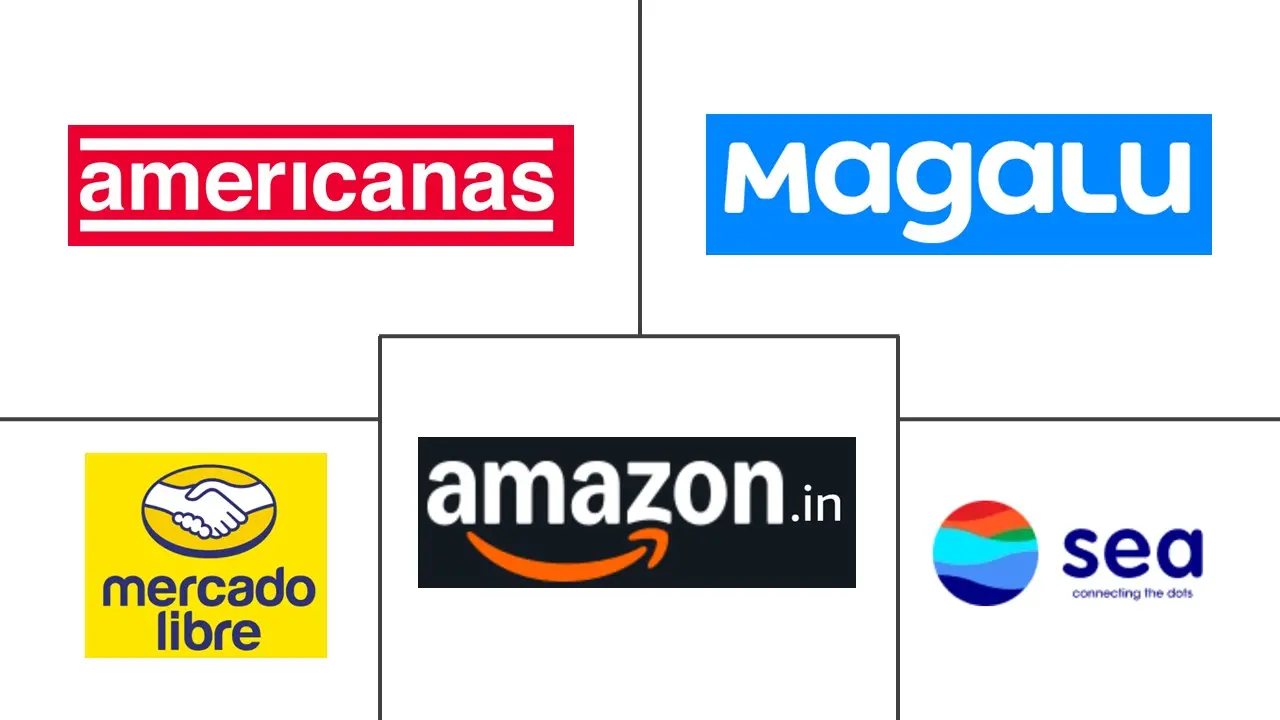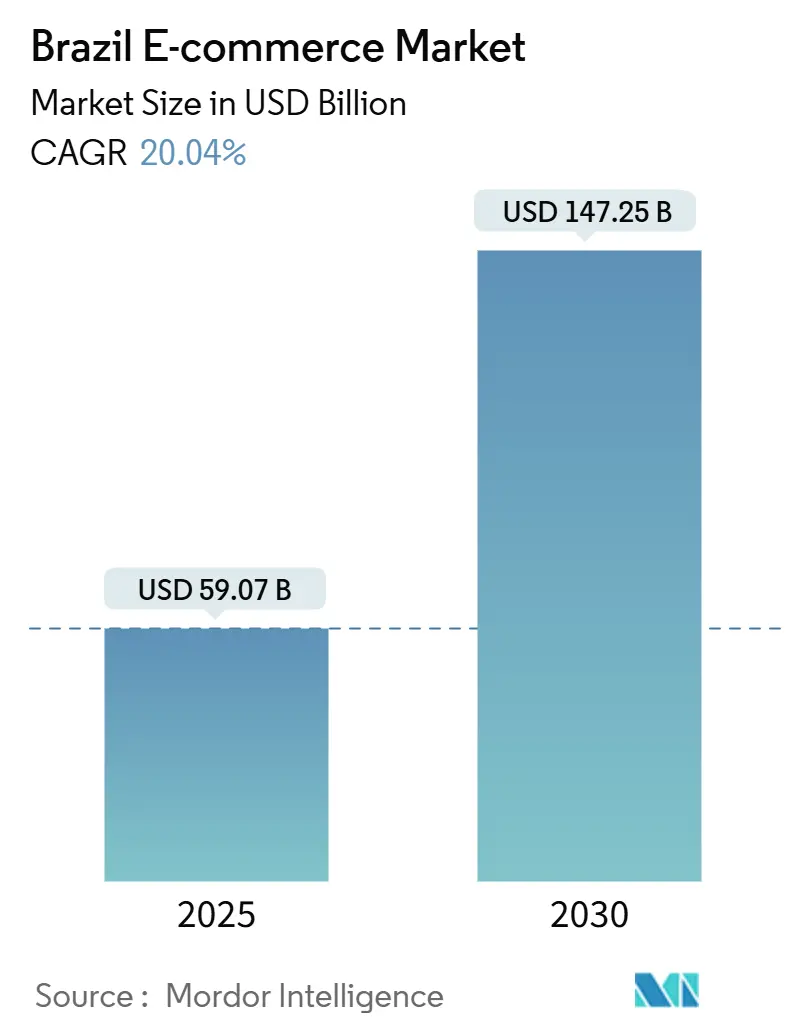
Brazil E-commerce Market Analysis by Mordor Intelligence
The Brazil ecommerce market size stands at USD 59.07 billion in 2025 and is forecast to advance to USD 147.25 billion by 2030, reflecting a rapid 20.04% CAGR. The expansion draws strength from Pix, which already processes more than 6 billion monthly transactions, and from sharply rising smartphone adoption that puts 217 million mobile connections into a nation of 212 million people. Immediate settlement through Pix is cutting merchants’ payment costs and pushing financial inclusion into secondary cities, while last-mile networks shorten delivery times sufficiently to meet emerging same-day expectations. Intensifying rivalry among Mercado Livre, Magazine Luiza, Amazon, Shopee and Temu is driving large-scale investment in fulfillment hubs, transport partnerships and open-banking credit tools. Food and beverage quick commerce, live-streaming sales and BNPL options are unlocking new spending from demographics that previously transacted only in cash, making the Brazil ecommerce market one of the world’s most dynamic retail arenas. [1]Banco Central do Brasil, “Pix En,” bcb.gov.br
Key Report Takeaways
- By business model, B2C commanded 86.2% of Brazil ecommerce market share in 2024; B2B is forecast to expand at a 22.3% CAGR through 2030.
- By device type, mobile transactions held 53% of the Brazil ecommerce market size in 2024, while mobile commerce is projected to climb at 21.6% CAGR.
- By payment method, credit and debit cards retained 31% share of the Brazil ecommerce market size in 2024; BNPL records the strongest 22.5% CAGR to 2030.
- By B2C product category, fashion led with 25% revenue share in 2024; food and beverages are forecast to rise at a 20.8% CAGR to 2030.
- By company, Mercado Livre, Magazine Luiza, Amazon, Shopee, Americanas and Temu together attracted 51.5% of total visits in October 2024, with Mercado Livre leading at 13.4% share.
Brazil E-commerce Market Trends and Insights
Drivers Impact Analysis
| Driver | (~) % Impact on CAGR Forecast | Geographic Relevance | Impact Timeline |
|---|---|---|---|
| Rapid adoption of instant payments (Pix) | +4.5% | National, with higher impact in urban centers | Short term (≤ 2 years) |
| Rising smartphone and broadband penetration | +3.8% | National, with emerging impact in secondary cities | Medium term (2-4 years) |
| Expansion of last-mile and same-day logistics | +3.2% | Urban centers, expanding to secondary cities | Medium term (2-4 years) |
| Open-Banking–driven credit innovations | +2.9% | Major metropolitan areas | Medium term (2-4 years) |
| Social-commerce and live-streaming boom | +2.6% | National, with higher adoption among younger demographics | Short term (≤ 2 years) |
| Growth of dark-stores in secondary cities | +2.1% | Secondary cities and emerging urban centers | Medium term (2-4 years) |
| Source: Mordor Intelligence | |||
Rapid Adoption of Instant Payments (Pix)
Pix counts 153 million users, equal to 75% of Brazil’s population, and 15 million business accounts. The platform handled 42 billion transactions worth BRL 17.2 trillion (USD 3.5 trillion) in 2023, establishing itself as the settlement rail of choice for merchants seeking cash-flow velocity and minimal fees. [2]Carlos Eduardo Brandt, “Pix: The Latest Updates on Brazil’s Leading Instant Payment Scheme,” europeanpaymentscouncil.eu Small and medium enterprises benefit disproportionately because Pix eliminates interchange costs that traditionally eroded margins. The Central Bank’s June 2025 launch of recurring-payment functionality enables subscriptions for digital content, utilities and SaaS offerings, broadening revenue visibility for merchants. Ongoing fraud-mitigation rules, including March 2025 key-registration validation, further build user confidence. Widely expected dominance of Pix in ecommerce by 2026 materially lifts the Brazil ecommerce market growth outlook.
Rising Smartphone and Broadband Penetration
Internet users reached 183 million in early 2025, producing 86.2% penetration. Median mobile download speed moved to 80.97 Mbps and fixed to 183.56 Mbps, enabling video-based shopping and augmented-reality try-ons.[3]Nicolò Gozzi, “Bridging the Digital Divide: Mapping Internet Connectivity Evolution, Inequalities, and Resilience in Six Brazilian Cities,” epjds.epj.org Although 13% of areas around education facilities continue to see speeds below 80 Mbps, connectivity gaps narrow each quarter, pulling first-time shoppers from interior regions into the Brazil ecommerce market. Telcos bundle low-cost data plans with marketplace apps, supporting rising consumption of live-commerce streams and social-media storefronts.
Expansion of Last-Mile and Same-Day Logistics
Between 2024 and 2025, Shopee opened twelve distribution centers and partnered with 20,000 drivers, including a new hub in Roraima that functions as a northern cross-border corridor. Concurrently, air-cargo providers lifted 118,000 tons in August 2024—evidence of ecommerce’s growing influence on aviation capacity. Mercado Livre’s 3,500 dedicated flights with Gollog in 2023 set a domestic benchmark for delivery speed. Same-day service in São Paulo, Rio de Janeiro and Belo Horizonte is now a default expectation. This dense network lowers cart-abandonment, pushes conversion and accelerates overall Brazil ecommerce market adoption.
Open-Banking Credit Innovations
Open finance lets lenders pull transactional histories from multiple institutions, improving scoring accuracy for underbanked shoppers. BNPL volume is on track to reach USD 4.66 billion in 2025 and USD 7.43 billion by 2030, underpinned by providers such as Addi that connect interest-free instalments to Pix settlement rails. Brazil’s emerging CBDC, DREX, will add programmable money attributes that strengthen auditability and speed up disbursements. Expanded credit access directly raises average ticket sizes, translating into higher order values within the Brazil ecommerce market.
Restraints Impact Analysis
| Restraint | (~) % Impact on CAGR Forecast | Geographic Relevance | Impact Timeline |
|---|---|---|---|
| High logistics cost and road bottlenecks | -1.5% | National, with higher impact in remote regions | Long term (≥ 4 years) |
| High mobile-data cost for low-income users | -1.2% | National, particularly affecting rural areas | Medium term (2-4 years) |
| New import-tax rules on cross-border buys | -0.8% | National | Short term (≤ 2 years) |
| Fraud risk and chargebacks on Pix system | -0.7% | National | Short term (≤ 2 years) |
| Source: Mordor Intelligence | |||
High Logistics Cost and Road Bottlenecks
Brazil will add 36% more urban cargo vehicles by 2030, magnifying congestion and inflating delivery budgets. Pothole-ridden corridors between north and northeast states often double delivery times compared with southeast routes. To offset cost pressures, platforms pilot micro-fulfillment lockers and route-optimization algorithms, yet fuel prices and tolls still erode margins in heavier product lines such as furniture and large electronics.
New Import-Tax Rules on Cross-Border Buys
August 2024 legislation imposed a 20% import tax on parcels up to USD 50 and 60% on USD 50.01 – 3,000, triggering a 40% drop in inbound orders during the first month. Asian platforms, including Shein, saw customer traffic slip from 69% of share in 2023 to 53.2% in 2024. Domestic retailers gained relief from low-priced competition, but shoppers near border states shifted to regional platforms or postponed discretionary imports, shaving points off overall Brazil ecommerce market growth.
Segment Analysis
By Business Model: B2B Momentum Builds Under Dominant B2C
The B2C format captured 86.2% of the Brazil ecommerce market in 2024, cemented by two-decade investments in consumer engagement and nationwide seller marketplaces. Average order frequency among repeat buyers hit 25 transactions per year in major cities, driven by free-shipping subscriptions and same-day delivery promises. Fintech-enabled checkout and video merchandising keep conversion rates high among fashion, beauty and consumer-electronics shoppers.
Despite this scale, B2B commerce is the growth engine, expanding at 22.3% CAGR to 2030. Digital procurement portals such as Compra Agora give corner stores next-day replenishment on fast-moving consumer goods, while open-banking APIs provide instant trade credit. The Brazil ecommerce market size for B2B transactions is already estimated at three times consumer volume, signalling vast headroom. As wholesalers digitize catalogues and integrate with ERP systems, B2B will systematically erode manual purchase-order flows, though B2C should retain majority share this decade.
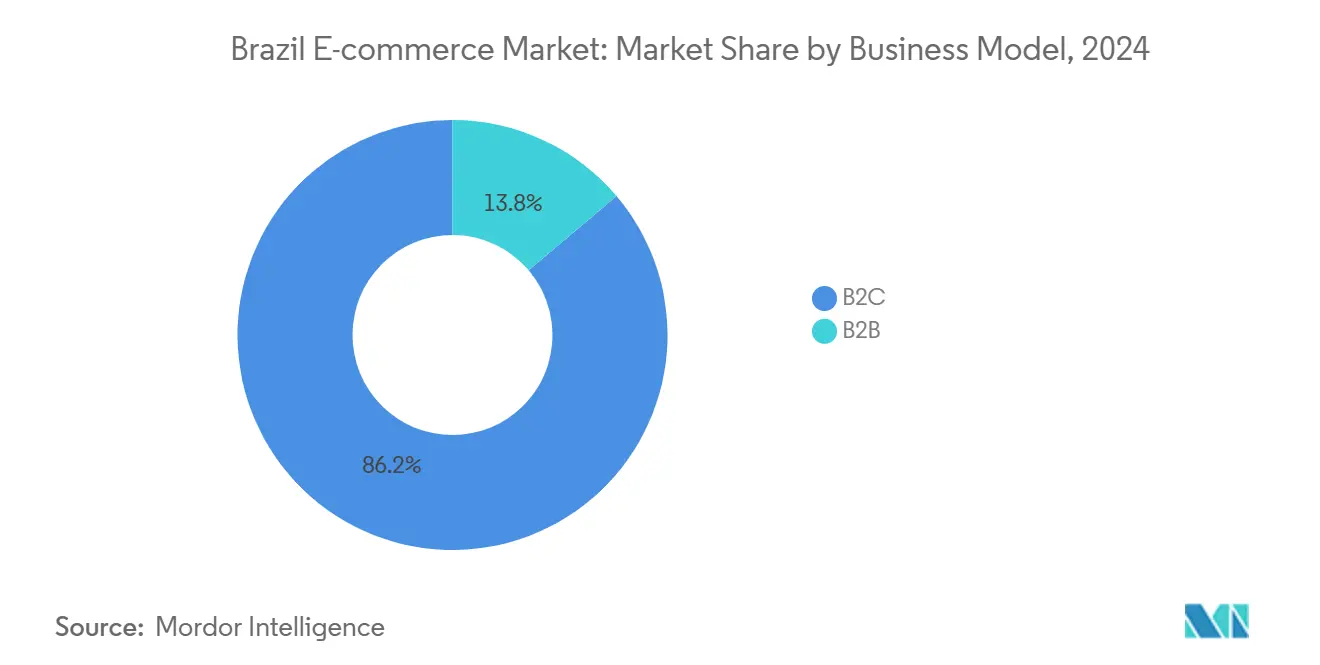
By Device Type: Smartphones Set Conversion Standard
Mobile checked out 53% of orders and is projected to sustain 21.6% CAGR, outdistancing desktop’s low-single-digit trajectory. Video-rich feeds and one-hand scrolling power brand storytelling, while biometric login shortens guest checkout to two taps. The Brazil ecommerce market size associated with mobile apps surpassed USD 30 billion in 2025, and app-exclusive flash deals keep daily active users climbing.
Desktop remains critical for research-heavy categories such as appliances and furniture, where larger screens aid specification comparison. Nonetheless, merchants funnel traffic into mobile loyalty programs with gamified reward points and QR-code offline-to-online prompts. Voice assistants and smart-TV click-to-buy segments expand slowly, but their share could double by 2030 as households embed connected devices into routine consumption.
By Payment Method: BNPL Extends Ticket Values While Pix Scales
Cards held 31% of the Brazil ecommerce market size in 2024, though share gradually slips as Pix and digital wallets multiply. BNPL balances accelerate 22.5% annually, with electronics and furniture averaging ticket sizes 1.4 times higher than card equivalents. Underwriting pulls behavioural signals from open-banking databases, reducing delinquency below 4%.
Pix’s substitution effect is clear: merchants offering Pix see 18% higher checkout completion than those that do not. Recurring Pix debits, activated in 2025, give subscription players predictable cash flow without gateway fees. Boleto Bancário continues serving unbanked segments, but volumes fall as agent networks digitize collection through QR codes linked to Pix. The Brazil ecommerce market share dynamics therefore tilt toward speed, certainty and embedded credit.
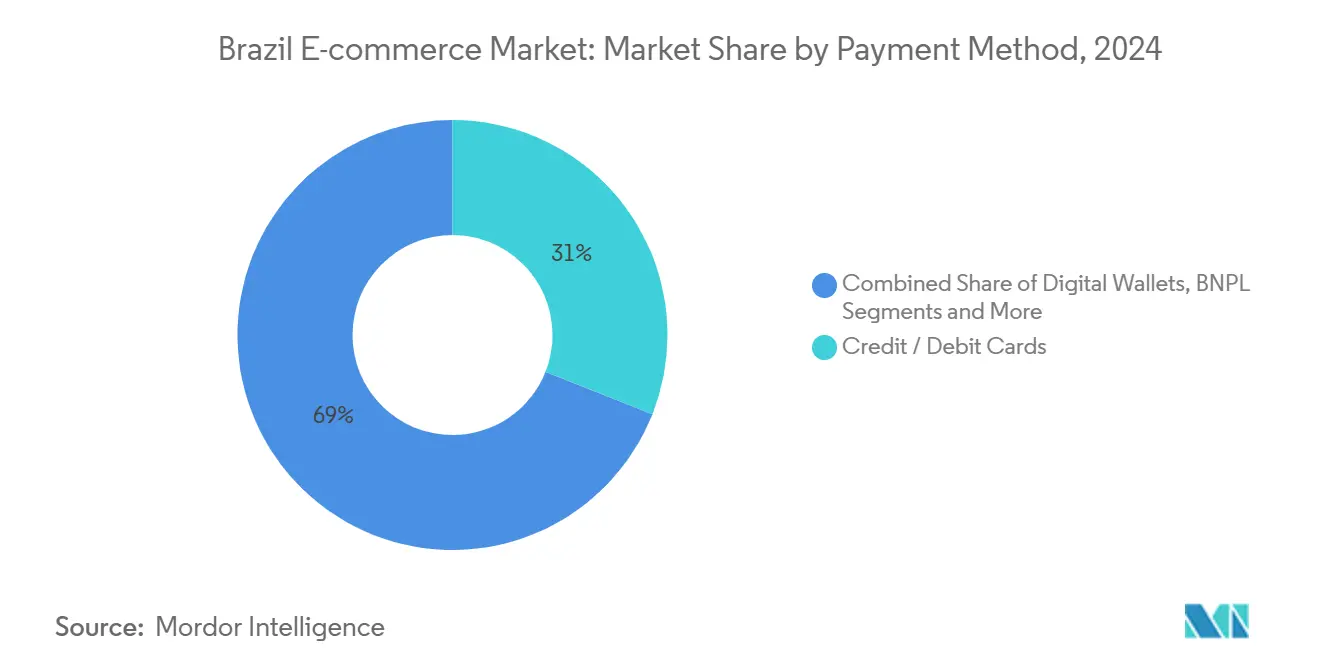
Note: Segment shares of all individual segments available upon report purchase
By B2C Product Category: Food and Beverage Leapfrogs as Cold Chain Matures
Fashion’s 25% revenue share reflects Brazilian enthusiasm for fast-fashion drops and influencer marketing. Returns logistics, historically a pain point, now rely on locker networks that accept barcode scans, improving resell speeds for merchants.
Food and beverages record the fastest 20.8% CAGR, fuelled by dark-store grids that place inventory within 3 km of dense residential clusters. Grocery players achieve 95% on-time rates in São Paulo, convincing households to shift weekly stock-up missions online. Electronics remain resilient, supported by warranty-bundling and same-day air-cargo lanes. Beauty products benefit from AR try-ons embedded in app cameras, while home goods experiment with 3D room-mapping before purchase. Together these shifts diversify category reliance and lift brand investment across the Brazil ecommerce market.
Geography Analysis
Southern and southeastern states anchor 62% of ecommerce transactions, leveraging higher disposable incomes and reliable fibre backbones. São Paulo alone generates more than USD 18 billion in annual gross merchandise value, and 35.4% of its restaurants operate delivery-only kitchens—a figure illustrating deep digital penetration. [4]Food Research International, “Rise of Dark Kitchens and Delivery-Only Restaurants in Brazil,” sciencedirect.com Competitive pilots for drone delivery and autonomous lockers typically launch here before rolling nationwide.
Secondary cities such as Campinas, Goiânia and Recife report triple-digit growth spurts as fulfilment centres extend one-day coverage footprints. Shopee’s Roraima hub shortens cross-border lead times to northern consumers and underpins the Brazil ecommerce market as a 42% share of the Latin American total. Improved 4G / 5G availability narrows the regional digital divide, drawing fresh cohorts of first-time shoppers.
Policy changes likewise shape geography: import-tax reforms curbed parcel inflow at São Paulo’s customs but prompted Temu to lease São Paulo warehouses, domesticating inventory to sidestep duties. Northeast states, once ecommerce laggards, now benefit from state incentives for last-mile lockers and data-centre investments, ensuring the Brazil ecommerce market becomes truly national in scope.
Competitive Landscape
The top six platforms command 51.5% of web traffic, signalling moderate concentration. Mercado Livre leads with 13.4% share and leverages a USD 4.6 billion 2024 Brazil capex plan that expands fulfilment automation, AI-driven recommendations and fintech penetration. Amazon appointed a new Brazil CEO in January 2025 to regain share lost to aggressive free-shipping campaigns by Shopee and Temu.
Shopee doubled its seller count to 2 million within 18 months and opened twelve distribution centres, using gaming-style vouchers to build frequency among young shoppers. Temu achieved BRL 3 billion (USD 590 million) revenue in six months despite the new import-tax regime, illustrating price elasticity among cost-conscious consumers. Domestic retailer Magazine Luiza filed a 2024 patent for an AI model that predicts purchase intent 30% better than legacy algorithms, aiming to cement loyalty via hyper-personalization.
White-space competition now shifts to integrated financial services. Mercado Pago offers working-capital loans to merchants, while Nubank aligns credit-card cash-back rewards with partner marketplaces. Social-commerce entrants, notably TikTok Shop, blur boundaries between content and commerce, forcing incumbents to embed live-stream modules and creator-affiliate programs directly into their apps to retain traffic inside the Brazil ecommerce market.
Brazil E-commerce Industry Leaders
Mercado Livre (MercadoLibre Inc.)
Amazon.com Inc.
Magazine Luiza S.A.
Americanas S.A.
Shopee (Sea Ltd.)
- *Disclaimer: Major Players sorted in no particular order
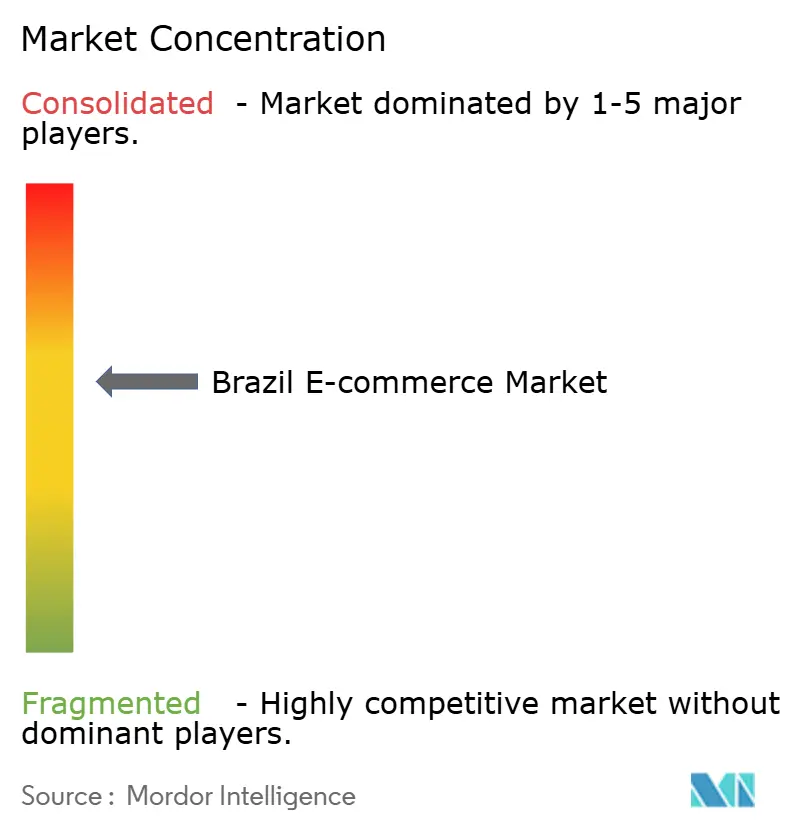
Recent Industry Developments
- May 2025: TikTok Shop launched operations in Brazil, combining short-video entertainment with real-time checkout to tap 91.75 million local users.
- May 2025: Uber and iFood formed a partnership that lets users order rides and meals in either app, creating a cross-platform convenience play.
- March 2025: The Central Bank required banks to delete Pix keys linked to irregular tax IDs, boosting payment-system security.
- January 2025: Amazon Brazil installed Juliana Sztrajtman as CEO to counter Shopee and Temu gains.
Research Methodology Framework and Report Scope
Market Definitions and Key Coverage
Our study defines Brazil's e-commerce market as every domestic or cross-border purchase of physical goods or paid services that is initiated, paid for, and fulfilled through an internet-enabled interface, whether a mobile app, web store, or social-commerce feed. All sales arising from business-to-consumer and business-to-business storefronts that settle in Brazilian real and are delivered to end users inside the country are included.
Scope exclusion: purely digital content such as video streaming subscriptions, in-game currencies, and resale of second-hand items are outside this estimate.
Segmentation Overview
- By Business Model
- B2C
- B2B
- By Device Type
- Smartphone / Mobile
- Desktop and Laptop
- Other Device Types
- By Payment Method
- Credit / Debit Cards
- Digital Wallets
- BNPL
- Other Payment Method
- By B2C Product Category
- Beauty and Personal Care
- Consumer Electronics
- Fashion and Apparel
- Food and Beverages
- Furniture and Home
- Toys, DIY and Media
- Other Product Categories
Detailed Research Methodology and Data Validation
Primary Research
We held structured interviews with executives of leading marketplaces, 3PL operators, and fintechs across Sao Paulo, Recife, and Porto Alegre, followed by shopper pulse surveys in tier-2 cities. Insights on Pix share, return rates, and average selling prices helped us validate secondary ratios and fine-tune regional weights.
Desk Research
Our analysts began with structured pulls from open data issued by bodies such as the Central Bank of Brazil (Pix transaction dashboards), the Brazilian Institute of Geography and Statistics, ABComm, and GSMA Intelligence. Trade filings, investor presentations, and marketplace traffic trackers supplied complementary signals on category splits, basket values, and logistics costs.
To ground company-level inputs, we consulted paid resources, D&B Hoovers for revenue splits and Dow Jones Factiva for historical news on platform launches, together with customs listings and Volza shipment indices to gauge cross-border flows. The sources cited here illustrate the range we used; many additional public and subscription datasets informed our desk research.
Market-Sizing & Forecasting
A top-down build started with total remote-payment volume, filtered by e-commerce share, average take-rate, and fraud reversal adjustments. Supplier roll-ups of sampled GMV and channel checks served as a bottom-up cross-test, and variances above five percent triggered reconciliation. Key model drivers include Pix transaction count, active online shoppers, smartphone connections, average basket value, logistics cost index, and cross-border share. Forecasts employ a multivariate regression linked to GDP per capita, mobile-broadband penetration, and instant-payment adoption, with scenario analysis to test taxation and logistics shocks.
Data Validation & Update Cycle
Outputs move through anomaly screens, peer review, and senior sign-off. Reports refresh annually; material events such as tax rule shifts prompt interim updates. Before delivery, a fresh data sweep ensures clients receive the latest view.
Why Mordor's Brazil E-commerce Baseline Commands Confidence
Published figures often diverge because firms pick different scopes, base years, and transaction filters. We focus on tangible goods plus paid services delivered domestically, apply constant-currency controls, and refresh the model every twelve months, which keeps our baseline tight and transparent.
Benchmark comparison
| Market Size | Anonymized source | Primary gap driver |
|---|---|---|
| USD 59.07 B (2025) | Mordor Intelligence | - |
| USD 346.0 B (2024) | Regional Payment Data Monitor | Includes digital media, ride-hailing, and all card-not-present recurring payments; no product segmentation |
| USD 455.6 B (2024) | Global Consultancy A | Combines B2B and B2C GMV, counts gross transaction value without fraud-return adjustment |
| USD 62.8 B (2023) | Trade Journal B | B2C only, uses local-currency figures converted at spot rates, older base year |
Taken together, the comparison shows that once scope inflation and currency effects are stripped out, Mordor's 2025 estimate offers a balanced, decision-ready baseline grounded in clearly auditable variables and repeatable steps.
Key Questions Answered in the Report
What is the current value of the Brazil ecommerce market?
The Brazil ecommerce market size is USD 59.07 billion in 2025.
How fast is the Brazil ecommerce market expected to grow?
The market is projected to post a 20.04% CAGR, reaching USD 147.25 billion by 2030.
Which payment method is expanding the quickest?
Buy Now, Pay Later services grow at 22.5% CAGR, boosted by Pix-linked instalment plans.
Why are food and beverage sales growing so rapidly online?
Dark-store networks and reliable cold-chain logistics now deliver groceries within an hour, driving a 20.8% CAGR in this category.
How did the 2024 import-tax reform affect cross-border ecommerce?
The new 20% duty on parcels up to USD 50 cut international orders by 40% in one month, giving domestic platforms a competitive edge.
What role does Pix play in Brazil’s ecommerce payment mix?
Pix processes more than 6 billion ecommerce transactions monthly, offering immediate settlement that lowers merchant fees and improves buyer experience.
